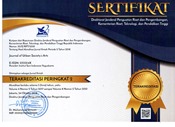Adaptation and Representation of Narcissistic Desires of Calon Arang's Text in Bali
Abstract
Rangda and Barong appear a lot in performing art, paintings, and tattoos in Bali. The sacred rituals involving the two creatures always attract attention—likewise forms of performances and crafts for tourists. Historically the existence of Rangda and Barong started from the text of Calon Arang, which initially came from the island of Java in Indonesia. This fact shows how the Balinese people attach themselves to myths and then develop them in creative works. The relationship between the narrative text and visualization will be the material to see what desires are behind their consciousness and unconsciousness in understanding the Calon Arang. There is an antagonistic offer on the characterizations and the creative process that perceives Calon Arang's story. The process of studying the object uses a qualitative method. In a time, observe and be directly involved in the Rangda and Barong ceremonies, see these figures' performances, visit markets and art galleries, and interview Balinese artists and cultural figures. This process concludes that the continuous adaptation process based on the Calon Arang text involves the spiritual and creative power of the Balinese people as part of their narcissistic and analytic desires. Rangda and Barong always provide new phenomena in creative works with antagonistic ideas. Analyzing this data is very important to understand the concepts created, outcomes, and the spirituality of the interwoven in the development of Balinese art.
Adaptasi dan Representasi Hasrat Narsis Teks Calon Arang di Bali. Rangda dan Barong merupakan figur yang sering terlihat pada pertunjukan seni, lukisan, dan tato di Bali. Agenda ritual sakral yang melibatkan keduanya selalu menarik perhatian. Demikian juga ketika ia muncul dalam bentuk pertunjukan dan kerajinan untuk wisatawan. Secara historis keberadaan Rangda dan Barong tidak bisa dilepaskan dari teks Calon Arang yang pada walnya berasal dari Pulau Jawa di Indonesia. Kenyaaan ini menunjukkan bagaimana keterikatan masyarakat Bali dengan mitos dan kemudian mengembangkannya dalam karya kreatif. Relasi teks naratif dan visualisasnya akan menjadi bahan untuk melihat hasrat apa yang ada di balik kesadaran dan ketidaksadaran mereka dalam menghayati Calon Arang. Terlihat adanya tawaran antagonistik pada penokohan dan proses kretif yang merpersepsi cerita Calon Arang. Proses pengkajian objek di atas menggunakan metode kualitatif. Selain mengamati dan terlibat langsung dalam upacara Rangda dan Barong, melihat pertunjukan yang melibatkan figur tersebut, mengunjungi pasar dan galeri seni, juga wawancara dengan beberapa seniman dan budayawan Bali. Proses ini memberikan simpulan bahwa proses adaptasi yang berkenajutan berdasar teks Calon Arang melibatkan daya spiritual dan kreatif masyarakat Bali sebagai bagian dari hasrat narsistik dan anaklitik. Rangda dan Barong selalu memberikan fenomena baru dalam karya kreatif dengan berbagai gagasan yang antagonistik. Menganalisis data ini sangat menarik untuk memahami gagasan penciptaan, keberlanjutan karya, dan jalinan spiritualitas dalam perkembangan seni Bali hingga saat ini.
Keywords
Full Text:
PDFReferences
Ananta Toer, P. (2010). Cerita Calon Arang. Lentera Dipantara.
Bandem, I. M., Berthe, L., & Hai, T. Q. (1972). Barong; Drame Musical Balinais. Ethnomusicology, 16(3). https://doi.org/https://doi.org/10.2307/850219
Barnard-Naudé, J. (2019). Lourens du Plessis’s Lesson: Love, Politics and Psychoanalysis in the Age of the Narcissist. Acta Academica, 51(1), 163–185. https://doi.org/https://doi.org/10.18820/24150479/aa51i1.9
Bracher, M. (1988). Lacan’s theory of the four discourses∗. Prose Studies, 11(3). https://doi.org/https://doi.org/10.1080/01440358808586349
Bracher, M. (2018). Lacan, Discourse, and Social Change: A Psychoanalytic Cultural Criticism. https://doi.org/https://doi.org/10.7591/9781501722295
Broussard, K. A., &, & Harton, H. C. (2018). Tattoo or taboo? Tattoo stigma and negative attitudes toward tattooed individuals. Journal of Social Psychology, 158(5). https://doi.org/https://doi.org/10.1080/00224545.2017.1373622
Budi Utama, I. W., Paramita, I. G. A., & Winarti, N. N. S. (2019). Perempuan dan Tantrayana. VIDYA WERTTA : Media Komunikasi Universitas Hindu Indonesia, 2(1). https://doi.org/https://doi.org/10.32795/vw.v2i1.319
Chambert-Loir, H. (Ed.). (2014). Sadur: Sejarah Terjemahan di Indonesia dan Malaysia (1st ed.). KPG (Kepustakaan Populer Gramedia) bekerja sama denganÉcole française d’Extrême-Orient, Forum Jakarta-Paris,Pusat Bahasa, dan Universitas Padjadjaran.
Cole, F.-C., &, & Belo, J. (1950). Bali: Rangda and Barong. Journal of the American Oriental Society, 70(4). https://doi.org/https://doi.org/10.2307/594980
Dian Saputra, I. M. (2019). The Mystisim Of Bhairawa Tantra In The Myth of Ida Ratu Gede Mas Macaling Dalem Nusa In The Balinese Cultural Tradition. Vidyottama Sanatana: International Journal of Hindu Science and Religious Studies, 3(1). https://doi.org/https://doi.org/10.25078/ijhsrs.v3i1.795
Florida, N. K. (2020). Writing the Past, Inscribing the Future. In History of Propechy in Colonial Java. Duke University Press Books. https://doi.org/https://doi.org/10.1515/9780822378662
Foley, K. (2022). Bali’s Rangda and Barong in Cosmic Balancing. In Monsters in Performance (1st ed., p. 21). Routledge.
Gray, N. (2015). “Sudamala” (freed from evil): exploring a ritual piece for Balinese gendér wayang. In Harris, Rachel, & R. Pease (Eds.), Pieces of the musical world: sounds and cultures (pp. 154–167). Routledge.
Heraty, T. (2000). Calon Arang: Kisah Perempuan Korban Patriarki: Prosa Lirik. Yayasan Obor Indonesia.
Hunter, T. M., & Pasek Ariati, N. W. (2021). Chapter 9 Rangda in the Calon Arang A Tale of Magic. In A Garland of Forgotten Goddesses. https://doi.org/https://doi.org/10.1525/9780520976214-013
Hutcheon, L. (1984). Narcissistic Narrative: The Metafictional Paradox. Poetics Today, 5(2). https://doi.org/https://doi.org/10.2307/1771945
Hutcheon, L. (2006). A theory of adaptation. In A Theory of Adaptation. https://doi.org/https://doi.org/10.4324/9780203957721
I Made, S. (1995). Calon arang dalam tradisi Bali: suntingan teks, terjemahan, dan analisis proses pem-Bali-an [Universitas Indonesia]. https://lontar.ui.ac.id/detail?id=20277700
Ibáñez, L. M. (2020). Penny dreadful (2014-2016). Postmodern mythology and ontology of otherness. Communication and Society, 33(1), 15–28. https://doi.org/10.15581/003.33.1.15-28
Imawati, E. (2021). Kosmologi Tantrayana di Bali dalam Menghadapi Pagebluk Wabah Penyakit. Caraka, 8(1), 44–62.
Jannarone, K. (2012). Artaud and His Doubles: A radical re-thinking of one of the most canonized figures in theater history, theory, and practice. Michigan Publising, University of Michigan Press. https://doi.org/10.3998/mpub.345778
Luh, S., & Seriadi, N. (2020). The Worship of Durgā in Bali (A Brief History, Perceptions, and Places of Worship of Goddess Durga in Bali). Jurnal Penelitian Agama Hindu, 4(3), 191–199.
McLain, K. (2019). Living the Bhagavad Gita at Gandhi’s ashrams. Religions, 10(11). https://doi.org/https://doi.org/10.3390/rel10110619
Mitoma, J., Bandem, I. M., DeBoer, F. E., & Bandem, I. M. (1985). Kaja and Kelod: Balinese Dance in Transition. Asian Theatre Journal, 2(1). https://doi.org/https://doi.org/10.2307/1124512
Opler, M. K. (1951). Bali: Rangda and Barong. Jane Belo. American Anthropologist, 53(3). https://doi.org/https://doi.org/10.1525/aa.1951.53.3.02a00140
Saidi, A. I. (2021). Narrative Patterns in Indonesian Fine Art. Britain International of Linguistics Arts and Education (BIoLAE) Journal, 3(1), 77–87. https://doi.org/10.33258/biolae.v3i1.411
Sarmidi, G. (2017). Perbandingan Representasi Moralitas Dalam Prosa Liris Pengakuan Pariyem Karya Linus Suryadi Dengan Calon Arang Perempuan Korban Patriarkhi Karya Toety Heraty. Moral Kemasyarakatan, 2(1), 45–58. https://doi.org/10.21067/jmk.v2i1.1817
Segara, I. N. Y. (2016). Aspects of Art, The Mystical Story and Religiosity of Rangda and Barong in Mamintar Ceremony in the Adat Village of Serangan. Mudra Jurnal Seni Budaya, 31(3), 332–341.
Sunarya, I. K. (2020). The concept of Rwa Bhineda Kriya on the Island of Bali Towards Jagadhita. Wacana Seni, 19, 47–60. https://doi.org/https://doi.org/10.21315/ws2020.19.4
Waki, F. (2020). Odysseus’s Eternal Return: Classical Reception in the Post-hermeneutical Framework of the Materialities of Literature. Agora - Estudos Classicos Em Debate, 22, 303–327. https://doi.org/https://doi.org/10.34624/agora.v0i22.14203
Wariati, N. L. G. (2020). Keberlangsungan Ajaran Sekte Bhairawa dalam Kehidupan Masyarakat Bali. Sphatika: Jurnal Teologi, 9(2), 94. https://doi.org/10.25078/sp.v9i2.1605
Weiss, S. (2017). Rangda and the Goddess Durga in Bali. Fieldwork in Religion, 12(1), 50–77. https://doi.org/https://doi.org/10.1558/firn.33750
Widjaja, S., & Nesia, N. L. (2014). Barong Kuntisraya: Ikon Seni Pertunjukan Bali Kontemporer. BP STIKOM Bali.
Zarrilli, P. B., Bandem, I. M., DeBoer, F. E., Drewal, H. J., Armstrong, R. P., Kapferer, B., Daniel, E. V., & Grimes, R. L. (1986). Toward a Definition of Performance Studies, Part II. Theatre Journal, 38(4). https://doi.org/https://doi.org/10.2307/3208301
Zwissler, L. (2018). In the study of the witch: Women, shadows, and the academic study of religions. Religions, 9(4). https://doi.org/https://doi.org/10.3390/REL9040105
DOI: https://doi.org/10.24821/jousa.v9i2.6486
Refbacks
- There are currently no refbacks.

This work is licensed under a Creative Commons Attribution 4.0 International License. ISSN 2355-2131 (print) | ISSN 2355-214X (online).







